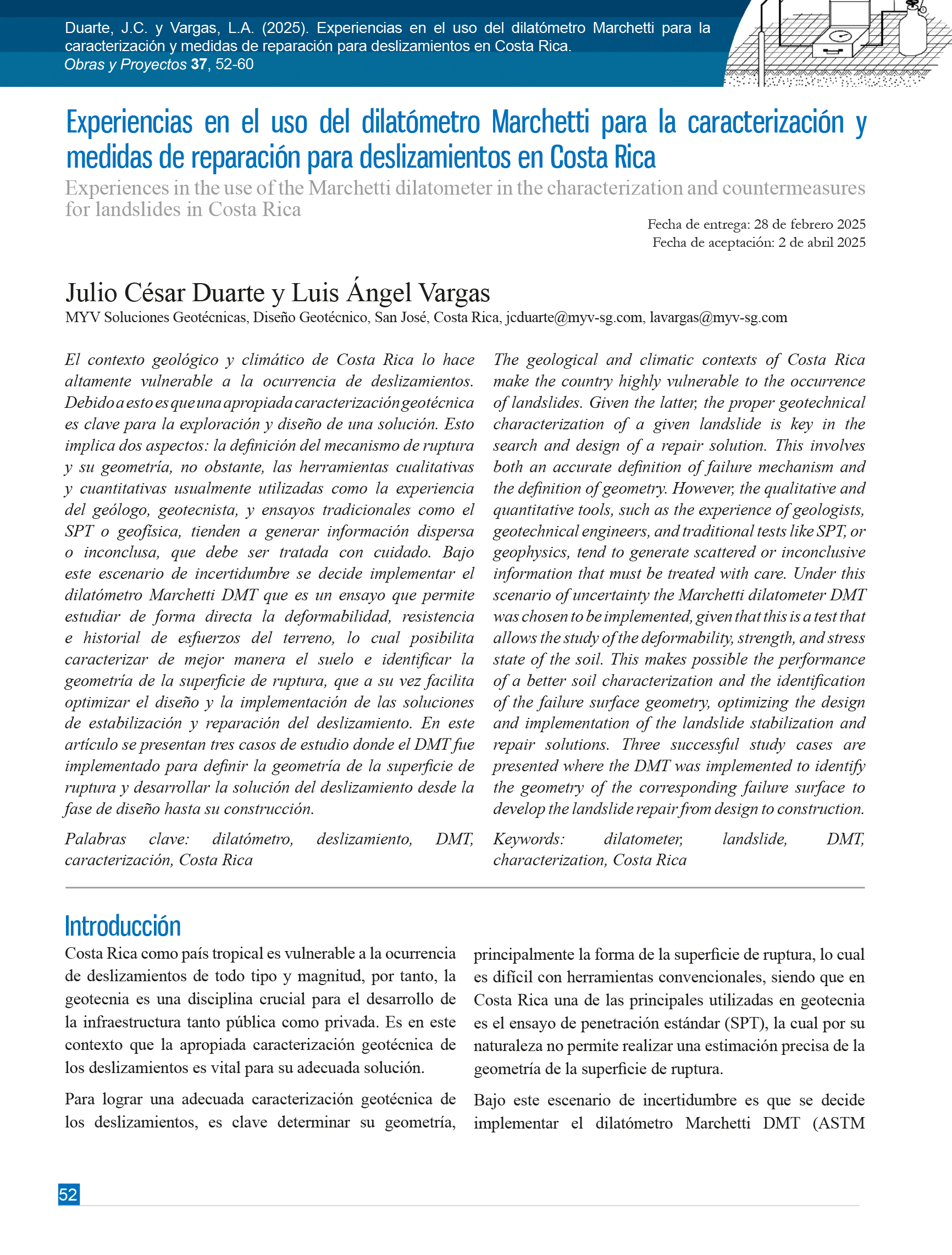Experiences in the use of the Marchetti dilatometer in the characterization and countermeasures for landslides in Costa Rica
DOI:
https://doi.org/10.21703/0718-2813.2025.37.3236Keywords:
Dilatometer, Landslide, DMT, Characterization, Costa RicaAbstract
The geological and climatic contexts of Costa Rica make the country highly vulnerable to the occurrence of landslides. Given the latter, the proper geotechnical characterization of a given landslide is key in the search and design of a repair solution. This involves both an accurate definition of failure mechanism and the definition of geometry. However, the qualitative and quantitative tools, such as the experience of geologists, geotechnical engineers, and traditional tests like SPT, or geophysics, tend to generate scattered or inconclusive information that must be treated with care. Under this scenario of uncertainty the Marchetti dilatometer DMT was chosen to be implemented, given that this is a test that allows the study of the deformability, strength, and stress state of the soil. This makes possible the performance of a better soil characterization and the identification of the failure surface geometry, optimizing the design and implementation of the landslide stabilization and repair solutions. Three successful study cases are presented where the DMT was implemented to identify the geometry of the corresponding failure surface to develop the landslide repair from design to construction.
References
ASTM D6635 (2017). Standard test method for performing the flat plate dilatometer. West Conshohocken, PA, USA.
Denyer, P. y Arias, O. (1991). Estratigrafía de la Región Central de Costa Rica. Revista Geológica de América Central 12: 1-59.
Grabar, K., Jug, J., Bek, A. and Strelec, S. (2024). Comparison of the piezocone penetrometer (CPTU) and flat dilatometer (DMT) methods for landslide characterisation. Geosciences 14(3): 64, 1-23.
Marchetti, S., Monaco, P., Totani, G. and Calabrese, M. (2001). The flat dilatometer test (DMT) in soil investigations. Report by the International Society of Soil Mechanics and Geotechnical Engineering ISSMGE Technical Committee TC16 on Ground Property Characterization from In-situ Testing.
Marchetti, S. (1980). In situ tests by flat dilatometer. Journal of the Geotechnical Engineering Division 106(3): 299-321.
Peiffer, H. (2016). A comparative analysis of the stability of a slope in an overconsolidated clay pit based on CPT and DMT measurements. International Conference on Geotechnical and Geophysical Site Characterization 5, B. Lehane, H.E. AcostaMartínez and R. Kelly (eds.). Sydney, Australia, Australian Geomechanics Society, vol. 2, 1359-1364.
Totani, G., Calabrese, M., Marchetti, S. and Monaco, P. (1997). Use of in situ flat dilatometer (DMT) for ground characterization in the stability analysis of slopes. XIV International Conference on Soil Mechanics and Foundation Engineering, Hamburg, Germany, vol. 1, 607-610.
Totani, G., Marchetti, S., Monaco, P. and Calabrese, M. (2001). Use of the flat dilatometer test (DMT) in geotechnical design. International Conference on In Situ Measurement of Soil Properties, Bali, Indonesia.
Vargas, L.A. and Coto, M. (2012). Experiences in the use of DMT – SDMT in Costa Rica, Central America. International Conference on Geotechnical and Geophysical Site Characterization 4, R.Q. Coutinho and P.W. Mayne (eds.). Porto de Galinhas, Brazil, CRC Press, vol. 1, 375-382.

Downloads
Published
Issue
Section
License
Copyright (c) 2025 Universidad Católica de la Santísima Concepción

This work is licensed under a Creative Commons Attribution-NonCommercial 4.0 International License.







